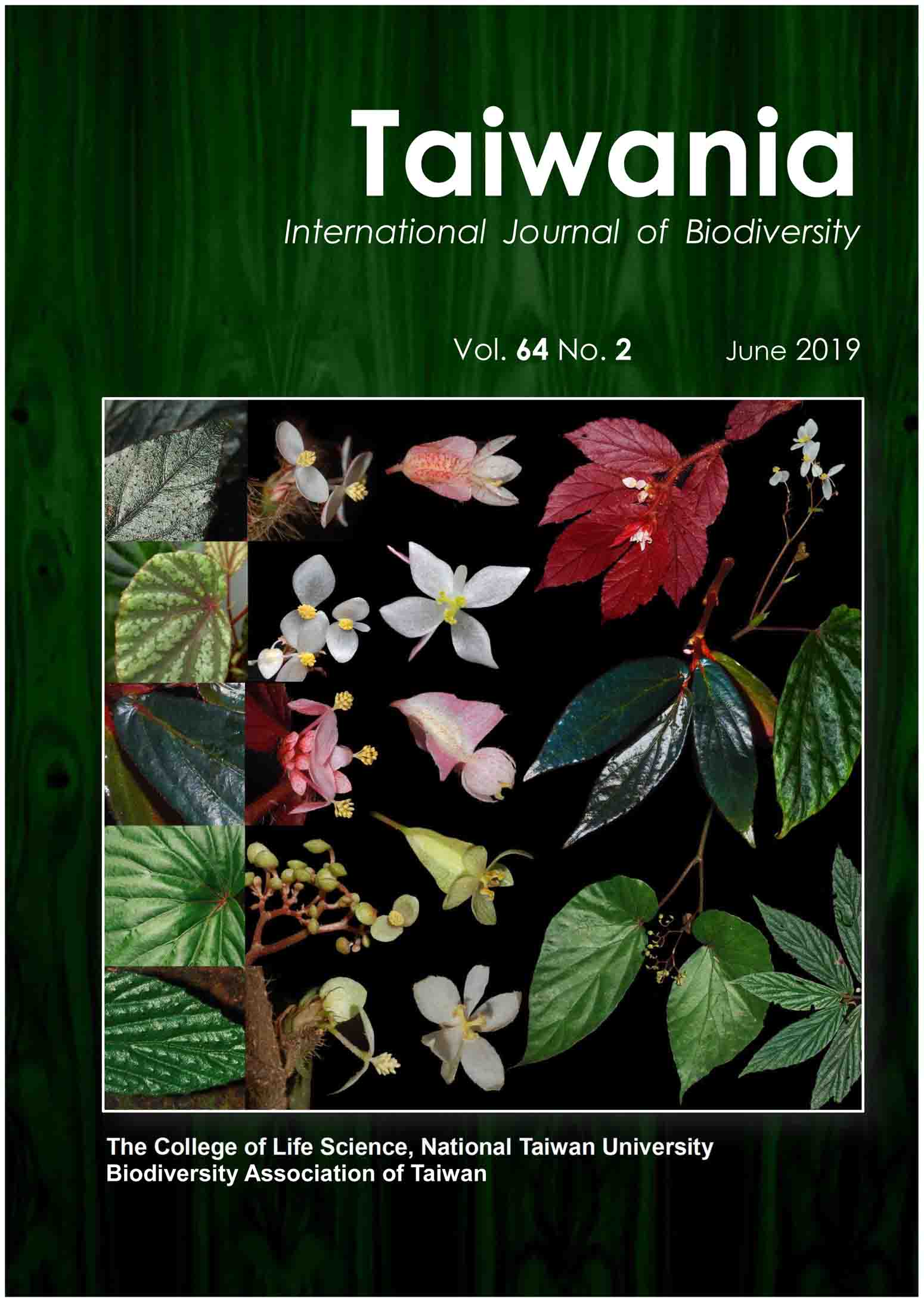Note
Nocturnal moths as potential pollinators of Marsdenia formosana (Apocynaceae: Asclepiadoideae)
Kota Sakagami, Satoru Matsubara, Shinji Sugiura
Published on: 08 May 2019
Page: 195 - 197
DOI: 10.6165/tai.2019.64.195
Abstract
Asclepiad flowers transfer the pollinaria, including pollen masses, to diverse body parts of flower visitors in various ways. In this study, we observed the insects visiting the flowers of Marsdenia formosana (Apocynaceae: Asclepiadoideae) at a forest in Taiwan in early May, 2016. Nocturnal moths of ten species (Lepidoptera: Pyralidae, Crambidae, Geometridae, Erebidae, and Noctuidae) were observed visiting M. formosana flowers. A pollinarium was found attached to the proboscis’ tip of a Bertula hadenalis persimilis (Lepidoptera: Erebidae) specimen. This suggests that nectar-seeking moths visit M. formosana flowers and involuntarily transfer the pollinaria on the tip of the proboscis.
Keyword: Erebidae, Lepidoptera, Nocturnal pollinators, Pollinarium attachment, Taiwan
Literature Cited
Bawa, K.S. 1990. Plant-pollinator interactions in tropical rain forests. Annu. Rev. Ecol. Syst. 21(1): 399-422.
DOI: 10.1146/annurev.ecolsys.21.1.399View Article
Google Scholar
Bertin, R.I. and M.F. Wilson. 1980. Effectiveness of diurnal and nocturnal pollination of two milkweeds. Can. J. Bot. 58(16): 1744-1746.
DOI: 10.1139/b80-202View Article
Google Scholar
Butterflies and moths of Taiwan. 2019. Online database of Taiwanese butterflies and moths. http://dearlep.tw. (11. Jan. 2019 accessed)
Darrault, R. O. and C. Schlindwein. 2005. Limited fruit production in Hancornia speciosa (Apocynaceae) and pollination by nocturnal and diurnal insects. Biotropica 37(3): 381-388.
DOI: 10.1111/j.1744-7429.2005.00050.xView Article
Google Scholar
Endress, M.E. and P.V. Bruyns. 2000. A revised classification of the Apocynaceae s.l. Bot. Rev. 66(1): 1-56.
DOI: 10.1007/BF02857781View Article
Google Scholar
Forster, P.I. 1989. Pollination of Marsdenia fraseri (Asclepiadaceae) by Metriorrhynchus lateralis (Coleoptera: Lycidae). Coleopt. Bull. 43: 311-312.
Gilbert, L.E. and M.C. Singer. 1975. Butterfly ecology. Annu. Rev. Ecol. Syst. 6(1): 365-395.
DOI: 10.1146/annurev.es.06.110175.002053View Article
Google Scholar
Hahn, M. and C.A. Br?hl. 2016. The secret pollinators: an overview of moth pollination with a focus on Europe and North America. Arthropod-Plant Interactions 10(1): 21-28.
DOI: 10.1007/s11829-016-9414-3View Article
Google Scholar
Johnson, S.D., M. Mor?, F.W. Amorim, W.A. Haber, G.W. Frankie, D.A. Stanley, A.A. Cocucci and R.A. Raguso. 2017. The long and the short of it: a global analysis of hawkmoth pollination niches and interaction networks. Func. Ecol. 31(1): 101-115.
DOI: 10.1111/1365-2435.12753View Article
Google Scholar
Ju?rez-Jaimes, B.V. and L. Lozada-P?rez. 2015. Marsdenia microcarpa, a new species of Marsdenia (Apocynaceae, Asclepiadoideae) from montane Guerrero, Mexico. Phytotaxa 217(1): 92-95.
DOI: 10.11646/phytotaxa.217.1.9View Article
Google Scholar
Kevan, P.G. and H.G. Baker. 1983. Insects as flower visitors and pollinators. Annu. Rev. Entomol. 28(1): 407-453.
DOI: 10.1146/annurev.en.28.010183.002203View Article
Google Scholar
Kishida, Y. (ed.) 2011. The Standard of Moths in Japan 2. Gakken Education Publishing, Tokyo, Japan. 416pp.
Mochizuki, K., S. Furukawa and A. Kawakita. 2017. Pollinia transfer on moth legs in Hoya carnosa (Apocynaceae). Am. J. Bot. 104(6): 953-960.
DOI: 10.3732/ajb.1700078View Article
Google Scholar
Morse, D.H. and R.S. Fritz. 1983. Contributions of diurnal and nocturnal insects to the pollination of common milkweed (Asclepias syriaca L.) in a pollen-limited system. Oecologia 60(2): 190-197.
DOI: 10.1007/BF00379521View Article
Google Scholar
Nakahama, N., R. Miura and T. Tominaga. 2013. Preliminary observations of insect visitation to flowers of Vincetoxicum pycnostelma (Apocynaceae: Asclepiadoideae), an endangered species in Japan. J. Entomol. Sci. 48(2): 151-160.
DOI: 10.18474/0749-8004-48.2.151View Article
Google Scholar
Nasu, Y., T. Hirowatari and Y. Kishida. (eds.) 2013. The Standard of Moths in Japan 4. Gakken Education Publishing, Tokyo, Japan. 552pp.
Ohashi, H., Y. Kadota, J. Murata, K. Yonekura and H. Kihara. 2017. Wild Flowers of Japan 4: Malvaceae~Apocynaceae. Heibonsha, Tokyo, Japan. 608pp.
Oliveira, P.E., P.E. Gibbs and A.A. Barbosa. 2004. Moth pollination of woody species in the Cerrados of Central Brazil: a case of so much owed to so few? Plant Syst. Evol. 245(1-2): 41-54.
DOI: 10.1007/s00606-003-0120-0View Article
Google Scholar
Ollerton, J., S. Liede-Schumann, M.E. Endress, U. Meve, A.R. Rech, A. Shuttleworth, H.A. Keller, M. Fishbein, L.O. Alvarado-Ca?rdenas et al. 2019. The diversity and evolution of pollination systems in large plant clades: Apocynaceae as a case study. Ann. Bot. 123(2): 311-325.
DOI: 10.1093/aob/mcy127View Article
Google Scholar
Pauw, A. 1998. Pollen transfer on birds’ tongues. Nature 394(6695): 731-732.
DOI: 10.1038/29421View Article
Google Scholar
Proctor, M., P. Yeo and A. Lack. 1996. The Natural History of Pollination. Timber Press, Portland, Oregon, USA. 479pp.
Sazatornil, F.D., M. Mor?, S. Benitez-Vieyra, A.A. Cocucci, I.J. Kitching, B.O. Schlumpberger, P.E. Oliveira, M. Sazima and F.W. Amorim. 2016. Beyond neutral and forbidden links: morphological matches and the assembly of mutualistic hawkmoth-plant networks. J. Anim. Ecol. 85(6): 1586-1594.
DOI: 10.1111/1365-2656.12509View Article
Google Scholar
Sugiura, S. and K. Yamazaki. 2005. Moth pollination of Metaplexis japonica (Apocynaceae): pollinaria transfer on the tip of the proboscis. J. Plant Res. 118(4): 257-262.
DOI: 10.1007/s10265-005-0216-4View Article
Google Scholar
Yeoh, Y.S., C.K. Yeo, W.F. Ang and Y.W. Low. 2013. Marsdenia maingayi (Apocynaceae, Asclepiadoideae), a rare rainforest woody climber rediscovered in Singapore. Gard. Bull. Singapore, 65: 241-249.


